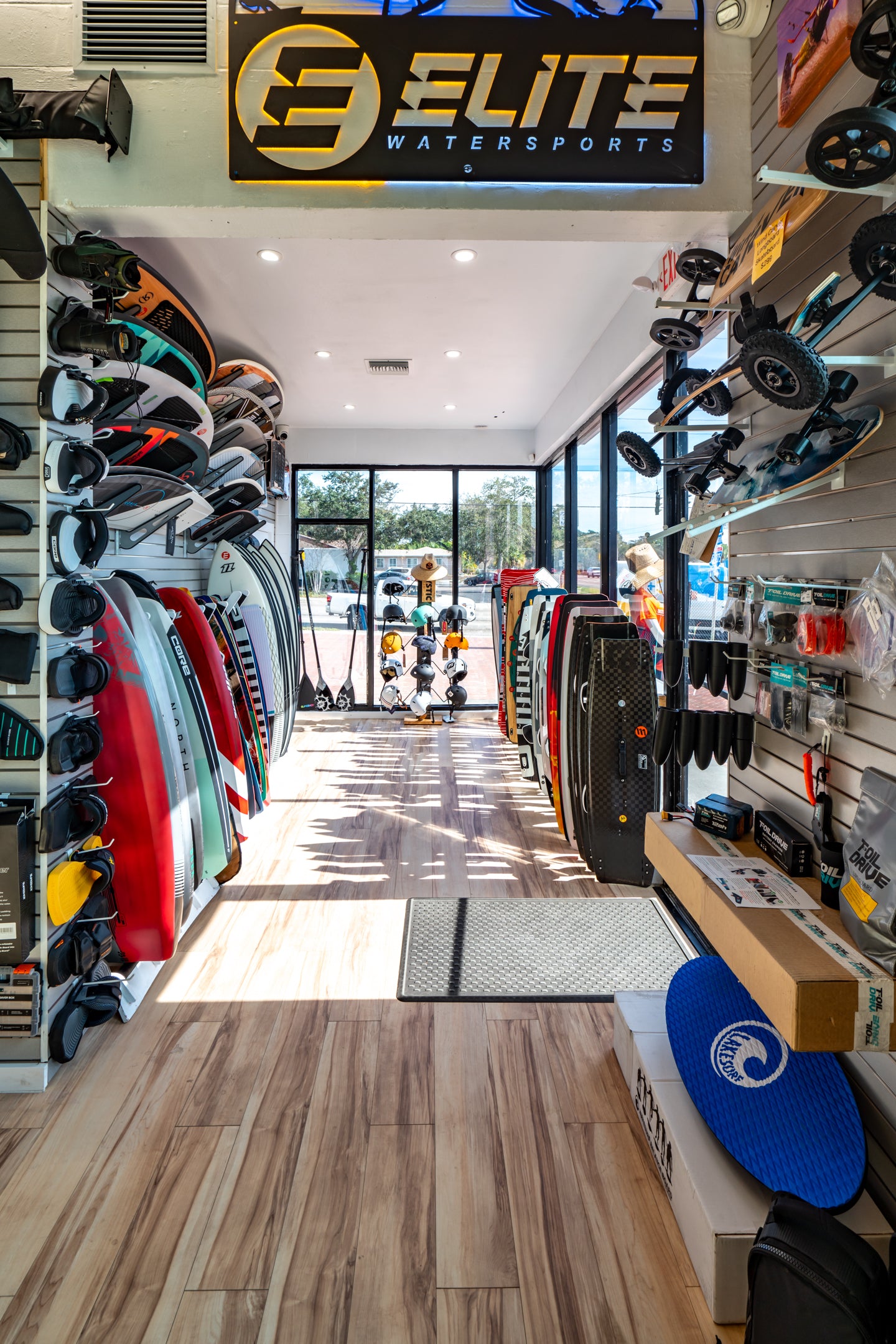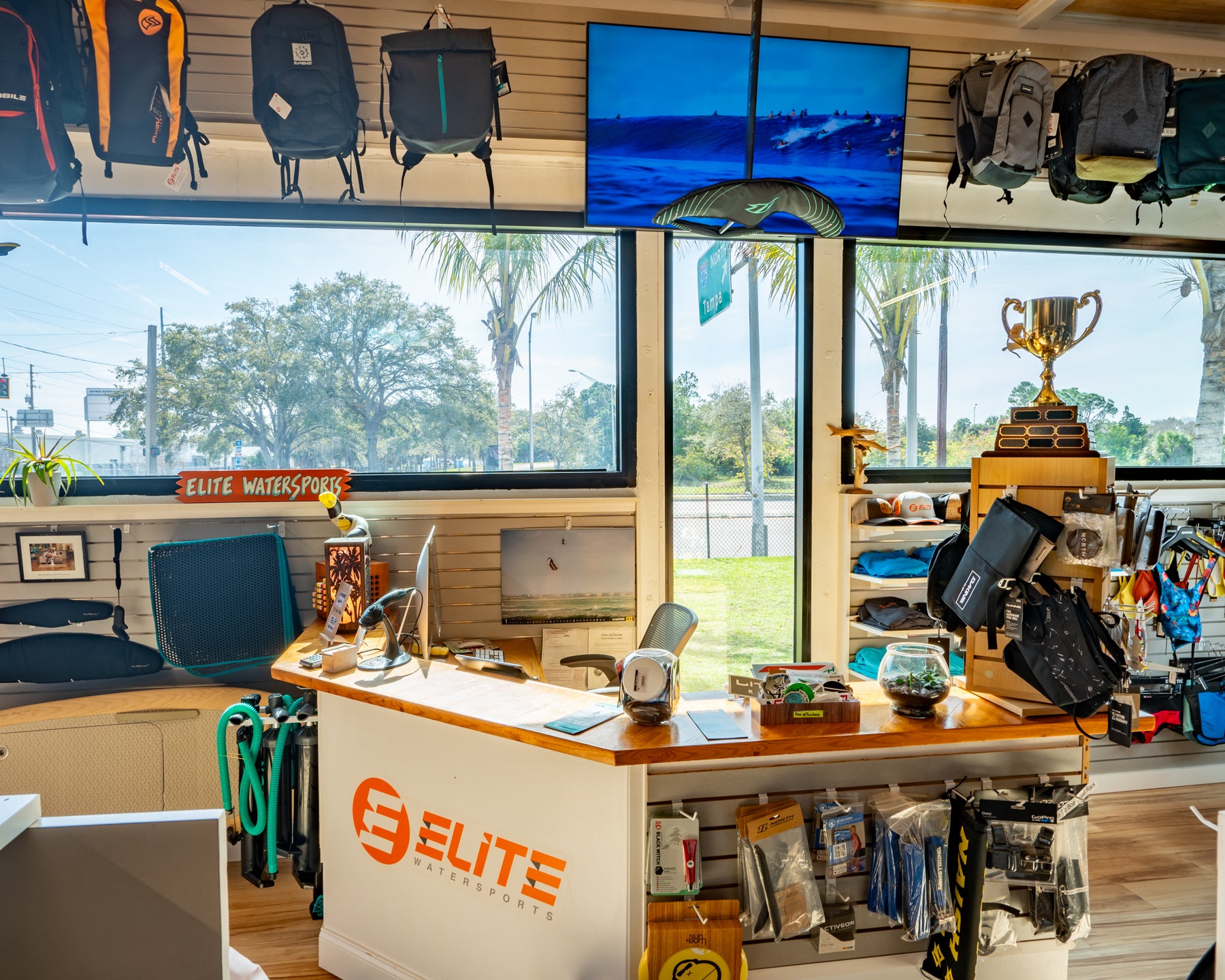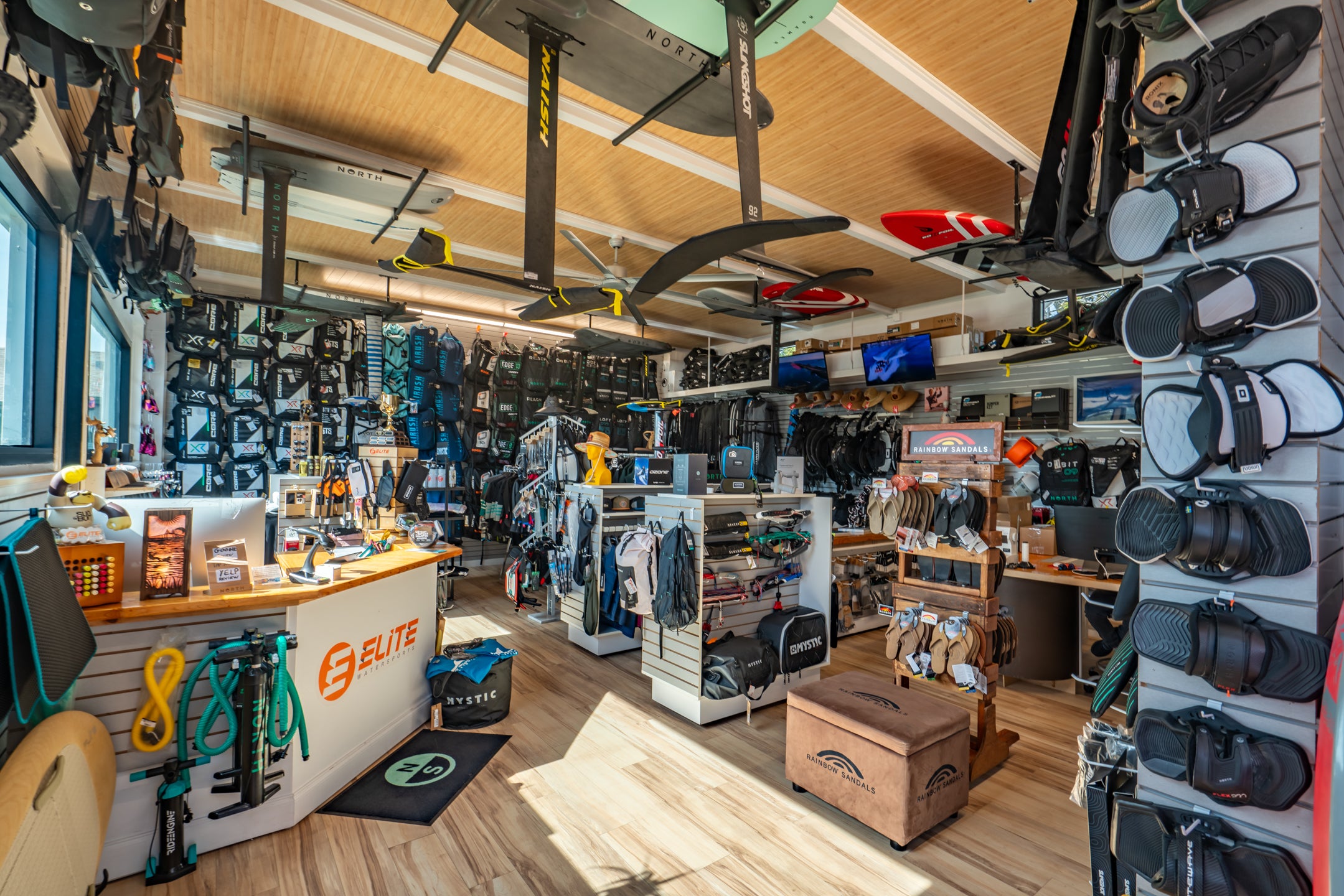ELITE WATERSPORTS
Last updated 8-25-2024
Kiteboarding & Kite Foil Relaunch.
Everything you need to know.

How do I get my kite to launch?
Aaron McClearnon has been teaching kiteboarding in Florida for over 10 years now. If you know anything about Florida, you know the wind can get seriously light in the summertime and nuking occasionally in the winter. He has some great insights and advanced techniques you can learn from to improve your kiteboarding relaunch skills.
In this article, we're diving deep into kiteboarding relaunch techniques. This isn't just for beginners—these tips and tricks are valuable for advanced riders, too.
Whether you're dealing with high winds or the dreaded low-wind days, mastering these techniques will significantly improve your kiteboarding.
Some of these tips will be essential if you are a kite foiler, but big air kiters and free-riders will also benefit. If you are new or just took kiteboarding lessons, this will be something you must focus on in the coming weeks. Let's get started!




Table Of Content
- Understanding kite relaunching
- How do I launch my kite in light wind? Hot Launch Explained.
- Kitefoil Relaunch Technique. Front Line Relaunch Technique.
- Advanced kiteboarding Relaunch. The Trailing-Edge Hot Launch.
- Final Tips for Successful Kite Relaunching.
- Where can I book kiteboarding lessons in Florida?
- Why Elite Watersports?
Understanding Kite Relaunching
Relaunching your kiteboarding kite is a fundamental skill every kiteboarder needs to master. Whether you're a beginner just getting your feet wet or an advanced rider looking to refine your skills, knowing how to effectively relaunch your kite can be the difference between a smooth session and swimming back in or having to self-rescue.
Where to practice relaunching your kite: These techniques are crucial in low-wind conditions where relaunching can be difficult. The key to a successful relaunch lies in practicing these techniques in shallow water first, where it's easier to manage the kite. You can stand and resist the kite's pull to help get it off the water. More importantly, you can walk out until you learn the technique. Once you've mastered it, you can move on to deeper waters. Remember that different situations may require different techniques, so it's important to be ready to switch from one method to another if your first attempt doesn't work.

Pro kiteboarding relaunch tips:
Movement is Key: When your kite is at the edge of the wind window but not relaunching, don't just stand still like a statue. Take a few steps into the breeze. This movement increases the apparent wind speed, giving your kite more power to lift off the water.
Sheet Your Steering Lines: Ensure you're using the correct amount of tension on your steering lines. Too much or too little can affect the kite's ability to catch the wind and relaunch properly. You can look at the wingtip of the kite and "sheet in" or "sheet out" with a single line. Pay attention and see if the wingtip is catching the wing or getting pushed down.
Stay Positive: Don't get frustrated if the kite doesn't relaunch on your first attempt. Sometimes, it's about finding the right balance of movement and tension to get it back in the air. This is a skill that you must practice after your kiteboarding lessons. It will improve with time.
How do I launch my kite in light wind? Hot Launch Explained
Hot launching: is a technique that should only be attempted in very light wind conditions, generally around 11 knots or under. This maneuver involves relaunching the kite when it is deep in the wind window, creating a powerful pull as the kite comes off the water.
Essential technique for Kite Foil: While this might sound intimidating, mastering the hot launch is an essential skill, particularly for kite foiling enthusiasts who often ride in lighter winds.
For twin-tip riders: The hot launch can also be a lifesaver if you are on the water when the wind suddenly drops. It provides a reliable way to get your kite back in the air with minimal wind; this technique allows you to safely return to shore or continue riding until the conditions improve.
Use with Caution: A hot launch generates a lot of power. Attempting this in anything other than very light wind can be dangerous, as the kite could shoot off the water with enough force to pull you off balance or worse.
Therefore, practicing this technique in controlled environments, ideally in water with light winds and far away from solid objects, is crucial.
Note: Never hot launch with someone or something downwind of you.

Tips for a Successful Hot Launch:
Be Aware of Your Surroundings: Because a hot launch generates so much power, always check for obstacles and be sure you have a clear path downwind.
This technique is best performed in open water with plenty of space to maneuver.
Use Small Movements: Precision is the key to a successful hot launch. Small, controlled movements are more effective than large, sweeping ones. Focus on gradually increasing tension on the lines rather than yanking them, which can destabilize the kite.
Practice in Light Wind Conditions: The hot launch is most effective in light winds, so use these conditions to practice. The more you practice, the more comfortable you'll become with the kite's behavior and the necessary line tension to execute the launch smoothly.
Understand Your Kite's Characteristics: Every kite behaves differently. Spend time understanding how your specific model responds during a hot launch. This understanding will help you anticipate the kite's movement and make the necessary adjustments in real-time.By mastering the hot launch technique, you'll be equipped to handle unexpected light wind situations and become a better kiteboarder. This skill is particularly valuable for foilers and anyone looking to expand their kiteboarding capabilities in more wind conditions.
Remember, safety comes first. Always ensure you have ample space downwind and practice in controlled environments before relying on the hot launch in more challenging conditions.
How to Execute a Hot Launch: Executing a hot launch requires a combination of proper technique and control.
Here's a step-by-step guide to mastering this essential skill:
Position Your Kite Deep in the Wind Window: Start by positioning your kite deep in the wind window, ideally at the 3:00 or 9:00 position, depending on the wind direction. The deeper the kite is in the wind window, the more potential power it will generate once it lifts off the water.
Create Slack in Your Steering Lines: Allow your steering lines to go slightly slack. This maneuver will help the kite sit back in the water and catch more wind as you initiate the relaunch.
Grab the Front Lines at the Depower Strap: Walk or swim up and grab the front lines where the depower strap is located. This strap serves as a perfect handle to pull the kite over into the wind.
Steady Pull with Front Line Pressure: Apply constant pressure on the front lines, pulling the kite up and over its leading edge. You want to roll the kite onto its trailing edge to catch the wind and relaunch.
This movement helps the kite pivot from the water surface and generate lift.
Prepare for the Burst of Power: As the kite begins to lift off, be ready for a burst of power. The deeper the kite is positioned in the wind window, the more forceful this burst will be. Lean back slightly to brace yourself against the initial pull, keeping your body weight low and centered to maintain balance.
Control the Ascent: Once the kite is in the air, use gentle steering to guide it up to a more stable position in the wind window. Avoid oversteering or making sudden movements, as this can cause the kite to lose wind and fall back into the water. When in doubt, you can always let go of the control bar.
Kitefoil Relaunch Technique. Front Line Relaunch Technique
The front-line relaunch is a less common technique but incredibly useful, especially in low-wind conditions or when you're foiling.
This one is a lifesaver when you can not get your kite to launch. I only learned this once I started riding and teaching in the lightest of winds. This technique has saved me more time than I can count in light wind now.
Study Aaron's video and make sure you learn this one.
Caution: Like the hot launch, this technique can be very dangerous in strong wind. Never attempt this above 10 knots.

Here's how it works:
Grab the Front Line: In deep water, reach up and grab one of the front lines.
Opposite Steering Line: Simultaneously, grab the opposite steering line to create an imbalance.
Pivot to Trailing Edge: This combination will cause the kite to pivot quickly onto its trailing edge. Sail it deep into the window and get a wingtip to catch. The kite will roll back similar to a 5 line c kite.
Launch or hot launch: From here, you can transition to a hot launch or continue steering with the front lines to get the kite airborne.
This technique is particularly effective because it allows you to manipulate the kite's position with minimal wind. It is a go-to for foilers or anyone riding in light wind conditions. It works similarly to how a 5-line C kite will relaunch.
Advanced kiteboarding Relaunch. The Trailing-Edge Hot Launch
The trailing edge hot launch is a bit more advanced and is used when the kite falls backward onto its trailing edge.
Remember, if you pull on the centerlines, the kite will shoot forward in whatever direction the leading edge is facing.
If the kite is facing straight up, it will shoot up. If the kite is facing sideways, it will shoot to the edge of the wind window.
For this to work like a hot launch, the kite needs to be deeper in the wind window. If it is already at the edge, it will shoot outside of the wind window and fall.
Grab the Front Lines: As before, reach up to grab the front lines. This time, your goal is to shoot the kite up into the wind window.
Monitor Kite Position: Pay attention to the kite's orientation. If it's facing off to one side (say 10:00 or 2:00), be prepared for it to shoot in that direction when it lifts off. Adjust your body position accordingly to stay balanced.
Stream the Water Off: Sometimes, water may collect on the kite's canopy. If this happens, walk or swim towards the kite to allow the water to drain off, then pull back to relaunch.
The trailing edge hot launch is handy when the kite has fallen into a difficult position. It allows you to reset the kite and get it back into the air without needing to swim back to shore.

Reverse Launch Technique:
The reverse launch is a technique every kiteboarder should have in their toolkit. It's beneficial for self-launches on the beach or when you're out in the water alone.
Positioning Your Bar: Before you begin, make sure to pre-spin your bar so that the red line (left side) is already in place. This preparation will help you avoid confusion during the launch.
Grip and Pull: Reach up past the leader lines and grip about a foot or so. Give a firm, controlled pull. The kite will lift backward off the water and rotate into the wind window.
Manage the Kite's Rotation: Adjust your grip to control its movement as the kite rotates. The goal is to bring it directly overhead at 12:00 to avoid any sudden lateral pulls.
The reverse launch can be a lifesaver in tricky situations. It offers a quick and controlled way to get your kite back in the air without needing help.
Final Tips for Successful Kite Relaunching
Practice in Varied Conditions: The more you practice in different wind and water conditions, the more adaptable you'll become. This adaptability is key to quickly assessing which technique to use in a given situation.
Stay Calm and Patient: Relaunching can be frustrating, especially in light wind. Stay calm, patient, and methodical in your approach.
Know When to Switch Techniques: If one method isn't working, don't waste time struggling. Be ready to switch to a different technique or combine elements of multiple methods to find what works.
Mastering these relaunch techniques will prepare you for any situation you encounter on the water. So get out there, practice, and take your kiteboarding skills to the next level!
Where can I book kiteboarding lessons in Florida?
Elite Watersports has been teaching beginner, intermediate and advanced kiteboarding lessons for over a decade.
We're happy to help you get better or even choose the right gear to get started or take your kiting to the next level.
Our location is the one of the easiest spots to learn and practice these skills. Book a lesson today.
Why Elite Watersports?
The expert team at Elite Watersports is here to serve. If you have any kiteboarding related questions call us. We can build custom kiteboarding packages, book kiteboarding lessons or simply offer helpful advice. We're your one stop shop for kiteboarding knowledge.
Swing by the shop and you can try on different kiteboarding harnesses and more.
If you need help deciding on your first kiteboarding kite give Elite Watersports a call. We're happy to set you up with your first kiteboarding kite.
(727)-800-2202



Author

Ryan "Rygo" Goloversic
Tags
Kiteboarding
kite launch
You May Also Like
Want To learn more about kiteboarding?
Follow us to receive the latest update on our journey experience

